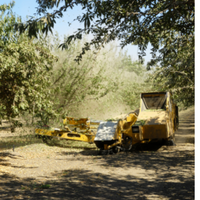
California almond farms in the U.S.A are 90% solely owned by generational families. The family-owned farmers play a crucial role in contributing to the economy in California. There are roughly about 7,600 almond growers in California. The united states of America are the world's leading almond producer 2,002,742 tonnes year

Almond trees are a 25-year investment almond orchards will produce their first yield five to twelve years after planting.
The central valley in California has a similar climate to the Mediterranean hot summers, and dry cool wet winters are supreme conditions for almond harvesting.
Almond harvest begins in August through to October.
Harvesting machines vigorously shake the almond orchard. The almond outer nutshell protects the almond nuts. Once this process is completed the almond nuts dry out on the ground in the warm, dry natural California sun for 7-10 days.

California is one of five regions where almonds are harvested, an estimated 80% of the world's almonds harvest is exported from California to the rest of the world. The remaining 20% of the almond harvest is exported from Spain, Italy, and Australia.
Almond production in the central valley yielded 370 million pounds of almonds in 1995, nearly 168 million kilograms.
2020 the department of agriculture in the U.S recorded a substantial almond harvest of 3.1 billion pounds and converted to a whopping 1.4 billion kilograms.
In 2020, almond growers increased their land dimensions from 1,958 square kilometres to 2,500 square kilometres.

California almond orchards need roughly 36 inches of water on average yearly. In 2022 statewide precipitation of 3.25 inches was only 25% of average rainfall.

Here lies the problem with the extensive increase in the property size of the almond orchards. How do the almond farmers keep almond crops safe with the everlasting drought and blistering temperatures on the rise?
A morning temperature of 104 degrees Fahrenheit on a summer morning speeds up the decomposition of dead almond trees. Exposed roots start turning to powder and rot in these extreme heat conditions. Almond farmers have known to let their almond trees die off due to the extreme heat and poor precipitation.

Almond growers also pull dead dried-up almond trees out of the dusty ground and turn them into mulch for gardening.
California is well known for extensive drought conditions, climate change is creating disastrous effects on the almond industry in the U .S. A
The California drought in December 2011 lasted 376 weeks and ended in March 2019.
Almonds farmers are, compelled to drill for water which is a costly production and has real-life threatening side effects for neighbouring communities and farms lands.
Creating uninhabitable living conditions and leaving-surrounding water supplies undrinkable.

Many almond growers are looking for innovative ways to water their almond orchards.
One very successful method is micro-irrigation. Driplines are delivered across the almond orchards and placed at the base of the almond tree directly to the root area. Micro-irrigation can decrease daily water consumption, increase yields and be less labour intensive.

Quoted By The Almond Board of California.
Previously farmers had flooded their fields or used large sprinklers. Results were positive by applying water directly to the roots rather than across the fields. Farmers conserved water and increased yields.

In fact, between the 1990s and 2010s, almond farmers reduced the amount of water used to grow each pound of almonds by 33 per cent.
Today, 85% of California almond farms use micro-irrigation, nearly two times the rate of California farms overall.
We know there is still more to be done, and that’s why we’re doing it.
By 2025, we commit to reducing the amount of water to grow a pound of almonds by an additional 20 per cent.

